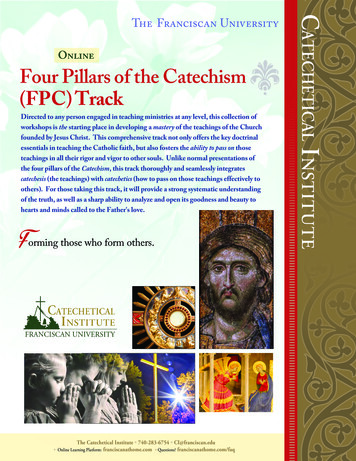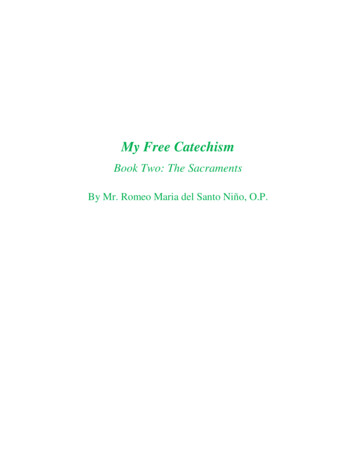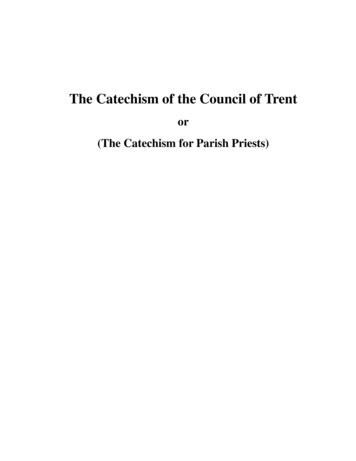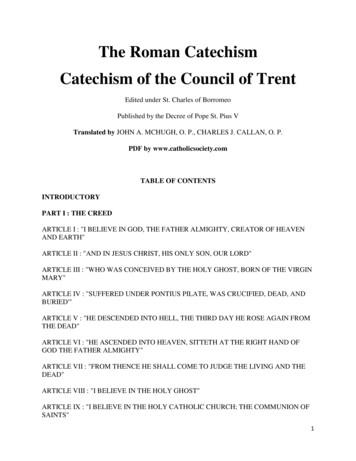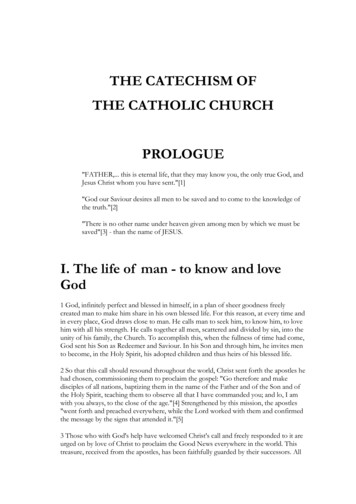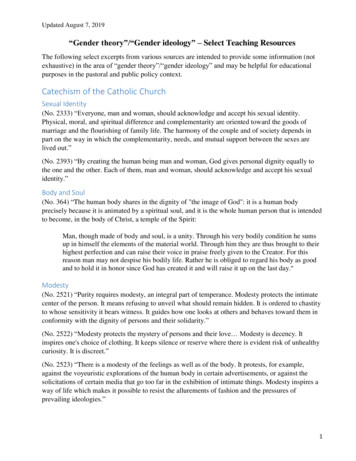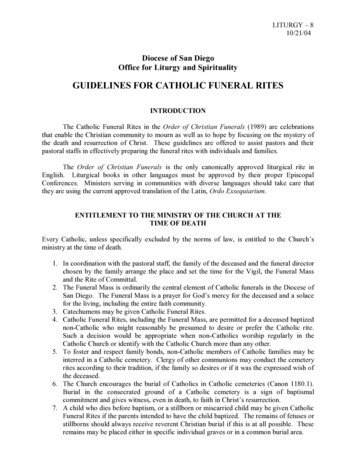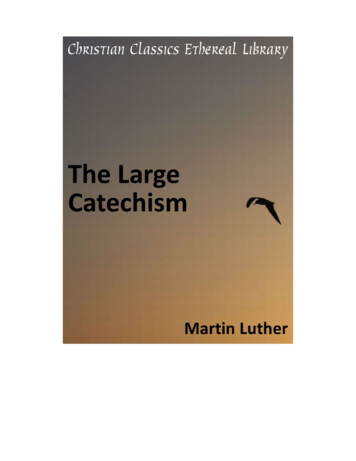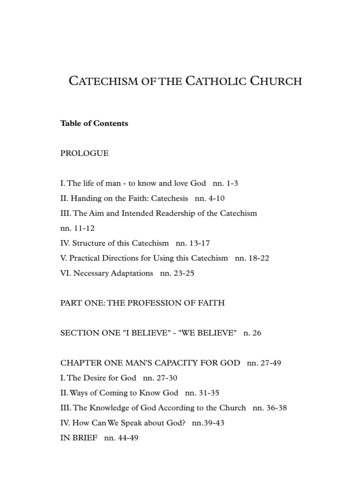
Transcription
CATECHISM OF THE CATHOLIC CHURCHTable of ContentsPROLOGUEI. The life of man - to know and love God nn. 1-3II. Handing on the Faith: Catechesis nn. 4-10III. The Aim and Intended Readership of the Catechismnn. 11-12IV. Structure of this Catechism nn. 13-17V. Practical Directions for Using this Catechism nn. 18-22VI. Necessary Adaptations nn. 23-25PART ONE: THE PROFESSION OF FAITHSECTION ONE "I BELIEVE" - "WE BELIEVE" n. 26CHAPTER ONE MAN'S CAPACITY FOR GOD nn. 27-49I. The Desire for God nn. 27-30II. Ways of Coming to Know God nn. 31-35III. The Knowledge of God According to the Church nn. 36-38IV. How Can We Speak about God? nn.39-43IN BRIEF nn. 44-49
CHAPTER TWO GOD COMES TO MEET MAN n. 50Article 1 THE REVELATION OF GODI. God Reveals His "Plan of Loving Goodness" nn. 51-53II. The Stages of Revelation nn. 54-64III. Christ Jesus -- "Mediator and Fullness of All Revelation" nn. 6567IN BRIEF nn. 68-73Article 2 THE TRANSMISSION OF DIVINE REVELATION n. 74I. The Apostolic Tradition nn.75-79II. The Relationship Between Tradition and Sacred Scripture nn. 80-83III. The Interpretation of the Heritage of Faith nn. 84-95IN BRIEF nn. 96-100Article 3 SACRED SCRIPTUREI. Christ - The Unique Word of Sacred Scripture nn. 101-104II. Inspiration and Truth of Sacred Scripture nn. 105-108III. The Holy Spirit, Interpreter of Scripture nn. 109-119IV. The Canon of Scripture nn. 120-130V. Sacred Scripture in the Life of the Church nn. 131-133IN BRIEF nn. 134-141CHAPTER THREE MAN'S RESPONSE TO GOD nn. 142-143Article 1 I BELIEVEI. The Obedience of Faith nn. 144-149II. "I Know Whom I Have Believed" nn. 150-152III. The Characteristics of Faith nn. 153-165Article 2 WE BELIEVE nn. 166-167
I. "Lord, Look Upon the Faith of Your Church" nn. 168-169II. The Language of Faith nn. 170-171III. Only One Faith nn. 172-175IN BRIEF nn. 176-184The CredoSECTION TWO I. THE CREEDS nn. 185-197CHAPTER ONE I BELIEVE IN GOD THE FATHER n. 198Article 1 "I BELIEVE IN GOD THE FATHER ALMIGHTY,CREATOR OF HEAVEN AND EARTH"Paragraph 1. I BELIEVE IN GOD nn. 199-231Paragraph 2. THE FATHER nn. 232-267Paragraph 3. THE ALMIGHTY nn. 268-278Paragraph 4. THE CREATOR nn. 279-324Paragraph 5. HEAVEN AND EARTH nn. 325-354Paragraph 6. MAN nn. 355-384Paragraph 7. THE FALL nn. 385-421CHAPTER TWO I BELIEVE IN JESUS CHRIST, THE ONLY SONOF GOD nn. 422-429ARTICLE 2 "AND IN JESUS CHRIST, HIS ONLY SON, OURLORD"I. Jesus nn. 430-435II. Christ nn. 436-440III. The Only Son of God nn. 441-445IV. Lord nn. 446-451
IN BRIEF nn. 452-455Article 3 "HE WAS CONCEIVED BY THE POWER OF THE HOLYSPIRIT, AND WAS BORN OF THE VIRGIN MARY"Paragraph 1. THE SON OF GOD BECAME MAN nn. 456-483Paragraph 2. "CONCEIVED BY THE POWER OF THE HOLYSPIRIT AND BORN OF THE VIRGIN MARY" nn. 484-511Paragraph 3. THE MYSTERIES OF CHRIST'S LIFE nn. 512-570Article 4 "JESUS CHRIST SUFFERED UNDER PONTIUSPILATE, WAS CRUCIFIED, DIED AND WAS BURIED" nn. 571573Paragraph 1. JESUS AND ISRAEL nn. 574-594Paragraph 2. JESUS DIED CRUCIFIED nn. 595-623Paragraph 3. JESUS CHRIST WAS BURIED nn. 624-630Article 5 "HE DESCENDED INTO HELL. ON THE THIRD DAYHE ROSE AGAIN" n. 631Paragraph 1. CHRIST DESCENDED INTO HELL nn. 632-637Paragraph 2. ON THE THIRD DAY HE ROSE FROM THE DEADnn. 638-658Article 6 "HE ASCENDED INTO HEAVEN AND IS SEATED ATTHE RIGHT HAND OF THE FATHER" nn. 659-664IN BRIEF nn. 665-667Article 7 "FROM THENCE HE WILL COME AGAlN TO JUDGETHE LIVING AND THE DEAD"I. He Will Come Again in Glory nn. 668-677II. To Judge the Living and the Dead nn. 678-679IN BRIEF nn. 680-682CHAPTER THREE I BELIEVE IN THE HOLY SPIRIT nn. 683686
ARTICLE 8 "I BELIEVE IN THE HOLY SPIRIT" nn. 687-688I. The Joint Mission of the Son and the Spirit nn. 689-690II. The Name, Titles, and Symbols of the Holy Spirit nn. 691-701III. God's Spirit and Word in the Time of the Promises nn. 702-716IV. The Spirit of Christ in the Fullness of Time nn. 717-730V. The Spirit and the Church In the Last Days nn. 731-741IN BRIEF nn. 742-747Article 9 "I BELIEVE IN THE HOLY CATHOLIC CHURCH" nn.748-750Paragraph 1. THE CHURCH IN GOD'S PLAN nn. 751-780Paragraph 2. THE CHURCH - PEOPLE OF GOD, BODY OFCHRIST, TEMPLE OF THE HOLY SPIRIT nn. 781-810Paragraph 3. THE CHURCH IS ONE, HOLY, CATHOLIC, ANDAPOSTOLIC nn. 811-870Paragraph 4. CHRIST'S FAITHFUL - HIERARCHY, LAITY,CONSECRATED LIFE nn. 871-945Paragraph 5. THE COMMUNION OF SAINTS nn. 946-962Paragraph 6. MARY - MOTHER OF CHRIST, MOTHER OF THECHURCH nn. 963-975Article 10 "I BELIEVE IN THE FORGIVENESS OF SINS" n. 976I. One Baptism for the Forgiveness of Sins nn. 977-980II. The Power of the Keys nn. 981-987Article 11 "I BELIEVE IN THE RESURRECTION OF THE BODY"nn. 988-991I. Christ's Resurrection and Ours nn. 992-1004II. Dying in Christ Jesus nn. 1005-1014IN BRIEF nn. 1015-1019Article 12 "I BELIEVE IN LIFE EVERLASTING" n. 1020
I. The Particular Judgment nn. 1021-1022II. Heaven nn. 1023-1029III. The Final Purification, or Purgatory nn. 1030-1032IV. Hell nn. 1033-1037V. The Last Judgment nn. 1038-1041VI. Hope of the New Heaven and the New Earth nn. 1042-1050IN BRIEF nn. 1051-1060"Amen" nn. 1061-1065PART TWO: THE CELEBRATION OF THE CHRISTIANMYSTERY nn. 1066-1075SECTION ONE THE SACRAMENTAL ECONOMY n. 1076CHAPTER ONE THE PASCHAL MYSTERY IN THE AGE OFTHE CHURCHArticle 1 THE LITURGY - WORK OF THE HOLY TRINITYI. The Father-Source and Goal of the Liturgy nn. 1077-1083II. Christ's Work in the Liturgy nn. 1084-1090III. The Holy Spirit and the Church in the Liturgy nn. 1091-1109IN BRIEF nn. 1110-1112Article 2 THE PASCHAL MYSTERY IN THE CHURCH'SSACRAMENTS n. 1113I. The Sacraments of Christ nn. 1114-1116II. The Sacraments of the Church nn. 1117-1121III. The Sacraments of Faith1122-1126IV. The Sacraments of Salvation nn. 1127-1129
V. The Sacraments of Eternal Life n. 1130IN BRIEF nn. 1131-1135CHAPTER TWO THE SACRAMENTAL CELEBRATION OF THEPASCHAL MYSTERY n. 1135Article 1 CELEBRATING THE CHURCH'S LITURGYI. Who Celebrates? nn. 1136-1144II. How is the Liturgy Celebrated? nn. 1145-1162III. When is the Liturgy Celebrated? nn. 1163-1178IV. Where is the Liturgy Celebrated? nn. 1179-1186IN BRIEF nn. 1187-1199Article 2 LITURGICAL DIVERSITY AND THE UNITY OF THEMYSTERY nn. 1200-1206IN BRIEF nn. 1207-1209SECTION TWO THE SEVEN SACRAMENTS OF THE CHURCHnn. 1210-1211CHAPTER ONE THE SACRAMENTS OF CHRISTIANINITIATION n. 1212Article 1 THE SACRAMENT OF BAPTISM n. 1213I. What is This Sacrament Called? nn. 1214-1216II. Baptism in the Economy of Salvation nn. 1217-1228III. How is the Sacrament of Baptism Celebrated? nn. 1229-1245IV. Who can Receive Baptism? nn. 1246-1255V. Who can Baptize? n. 1256VI. The Necessity of Baptism nn. 1257-1261
VII. The Grace of Baptism nn. 1262-1274IN BRIEF nn. 1275-1284Article 2 THE SACRAMENT OF CONFIRMATION n. 1285I. Confirmation in the Economy of Salvation nn. 1286-1292II. The Signs and the Rite of Confirmation nn. 1293-1301III. The Effects of Confirmation nn. 1302-1305IV. Who can Receive This Sacrament? nn. 1306-1311V. The Minister of Confirmation nn. 1312-1314IN BRIEF nn. 1315-1321Article 3 THE SACRAMENT OF THE EUCHARIST nn. 1322-1323I. The Eucharist - Source and Summit of Ecclesial Life nn. 1324-1327II. What is This Sacrament Called? nn. 1328-1332III. The Eucharist in the Economy of Salvation nn. 1333-1344IV. The Liturgical Celebration of the Eucharist nn. 1345-1355V. The Sacramental Sacrifice Thanksgiving, Memorial, Presence nn.1356-1381VI. The Paschal Banquet nn. 1382-1401VII. The Eucharist - "Pledge of the Glory To Come" nn. 1402-1405IN BRIEF nn. 1406-1419CHAPTER TWO THE SACRAMENTS OF HEALING nn. 14201421Article 4 THE SACRAMENT OF PENANCE ANDRECONCILIATION n. 1422I. What is This Sacrament Called? nn. 1423-1424II. Why a Sacrament of Reconciliation after Baptism? nn. 1425-1426III. The Conversion of the Baptized nn. 1427-1429
IV. Interior Penance nn. 1430-1433V. The Many Forms of Penance in Christian Life nn. 1434-1439VI. The Sacrament of Penance and Reconciliation nn. 1440-1449VII. The Acts of the Penitent nn. 1450-1460VIII. The Minister of This Sacrament nn. 1461-1467IX. The Effects of This Sacrament nn. 1468-1470X. Indulgences nn. 1471-1479XI. The Celebration of the Sacrament of Penance nn. 1480-1484IN BRIEF nn. 1485-1498Article 5 THE ANOINTING OF THE SICK n. 1499I. Its Foundations in the Economy of Salvation nn. 1500-1513II. Who Receives and Who Administers This Sacrament? nn. 15141516III. How is This Sacrament Celebrated? nn. 1517-1519IV. The Effects of the Celebration of This Sacrament nn. 1520-1523V. Viaticum, the Last Sacrament of the Christian nn. 1524-1525IN BRIEF nn. 1526-1532CHAPTER THREE THE SACRAMENTS AT THE SERVICE OFCOMMUNION nn. 1533-1535ARTICLE 6 THE SACRAMENT OF HOLY ORDERS n. 1536I. Why Is This Sacrament Called "Orders"? nn. 1537-1538II. The Sacrament of Holy Orders in the Economy of Salvation nn.1539-1553III. The Three Degrees of the Sacrament of Holy Orders nn. 15541571IV. The Celebration of This Sacrament nn. 1572-1574
V. Who Can Confer This Sacrament? nn. 1575-1576VI. Who Can Receive This Sacrament? nn. 1577-1580VII. The Effects of the Sacrament of Holy Orders nn. 1581-1589IN BRIEF nn. 1590-1600Article 7 THE SACRAMENT OF MATRIMONY n. 1601I. Marriage in God's Plan nn. 1602-1620II. The Celebration of Marriage nn. 1621-1624III. Matrimonial Consent nn. 1625-1637IV. The Effects of the Sacrament of Matrimony nn. 1638-1642V. The Goods and Requirements of Conjugal Love nn. 1643-1654VI. The Domestic Church nn. 1655-1658IN BRIEF nn. 1659-1666CHAPTER FOUR OTHER LITURGICAL CELEBRATIONSArticle 1 SACRAMENTALS nn. 1667-1676IN BRIEF nn. 1677-1679Article 2 CHRISTIAN FUNERALS n. 1680I. The Christian's Last Passover nn. 1681-1683II. The Celebration of Funerals nn. 1683-1690PART THREE: LIFE IN CHRIST nn. 1691-1698SECTION ONE MAN'S VOCATION LIFE IN THE SPIRIT n. 1699CHAPTER ONE THE DIGNITY OF THE HUMAN PERSON n.1700
Article 1 MAN: THE IMAGE OF GOD nn. 1701-1709IN BRIEF nn. 1710-1715Article 2 OUR VOCATION TO BEATITUDEI. The Beatitudes nn. 1716-1717II. The Desire for Happiness nn. 1718-1719III. Christian Beatitude nn. 1720-1724IN BRIEF nn. 1725-1729Article 3 MAN'S FREEDOM n. 1730I. Freedom and Responsibility nn. 1731-1738II. Human Freedom in the Economy of Salvation nn. 1739-1742IN BRIEF nn. 1743-1748Article 4 THE MORALITY OF HUMAN ACTS n. 1749I. The Sources of Morality nn. 1750-1754II. Good Acts and Evil Acts nn. 1755-1756IN BRIEF nn. 1757-1761Article 5 THE MORALITY OF THE PASSIONS n. 1762I. Passions nn. 1763-1766II. Passions and Moral Life nn. 1767-1770IN BRIEF nn. 1771-1775Article 6 MORAL CONSCIENCE n. 1776I. The Judgment of Conscience nn. 1777-1782II. The Formation of Conscience nn. 1783-1785III. To Choose in Accord With Conscience nn. 1786-1789IV. Erroneous Judgment nn. 1790-1794IN BRIEF nn. 1795-1802Article 7 THE VIRTUES n. 1803
I. The Human Virtues nn. 1804-1811II. The Theological Virtues nn. 1812-1829III. The Gifts and Fruits of the Holy Spirit nn. 1830-1832IN BRIEF nn. 1833-1845Article 8 SINI. Mercy and Sin nn. 1846-1948II. The Definition of Sin nn. 1849-1851III. The Different Kinds of Sins nn. 1852-1853IV. The Gravity of Sin: Mortal and Venial Sin nn. 1854-1864V. The Proliferation of Sin nn. 1865-1869IN BRIEF nn. 1870-1876CHAPTER TWO THE HUMAN COMMUNION n. 1877Article 1 THE PERSON AND SOCIETYI. The Communal Character of the Human Vocation nn. 1878-1885II. Conversion and Society nn. 1886-1889IN BRIEF nn. 1890-1896Article 2 PARTICIPATION IN SOCIAL LIFEI. Authority nn. 1897-1904II. The Common Good nn. 1905-1912III. Responsibility and Participation nn. 1913-1917IN BRIEF nn. 1918-1927Article 3 SOCIAL JUSTICE n. 1928I. Respect For the Human Person nn. 1929-1933II. Equality and Differences Among Men nn. 1934-1938III. Human Solidarity nn. 1939-1942
IN BRIEF nn. 1943-1948CHAPTER THREE GOD'S SALVATION: LAW AND GRACE n.1949Article 1 THE MORAL LAW nn. 1950-1953I. The Natural Moral Law nn. 1954-1960II. The Old Law nn. 1961-1964III. The New Law or the Law of the Gospel nn. 1965-1974IN BRIEF nn. 1975-1986Article 2 GRACE AND JUSTIFICATIONI. Justification nn. 1987-1995II. Grace nn. 1996-2005III. Merit nn. 2006-2011IV. Christian Holiness nn. 2012-2016IN BRIEF nn. 2017-2029Article 3 THE CHURCH, MOTHER AND TEACHER nn. 20302031I. Moral Life and the Magisterium of the Church nn. 2032-2040II. The Precepts of the Church nn. 2041-2043III. Moral Life and Missionary Witness nn. 2044-2046IN BRIEF nn. 2047-2051SECTION TWO THE TEN COMMANDMENTS nn. 2052-2074IN BRIEF nn. 2075-82
CHAPTER ONE YOU SHALL LOVE THE LORD YOUR GODWITH ALL YOUR HEART, AND WITH ALL YOUR SOUL, ANDWITH ALL YOUR MIND n. 2083Article 1 THE FIRST COMMANDMENTI. "You Shall Worship the Lord Your God and Him Only Shall YouServe" nn. 2084-2094II. "Him Only Shall You Serve" nn. 2095-2109III. "You Shall Have No Other Gods Before Me" nn. 2110-2128IV. "You Shall Not Make For Yourself a Graven Image . . ." nn. 21292132IN BRIEF nn. 2133-2141Article 2 THE SECOND COMMANDMENTI. The Name of the Lord is Holy nn. 2142-2149II. Taking the Name of the Lord in Vain nn. 2150-2155III. The Christian Name nn. 2156-2159IN BRIEF nn. 2160-2167Article 3 THE THIRD COMMANDMENTI. The Sabbath Day nn. 2168-2173II. The Lord's Day nn. 2174-2188IN BRIEF nn. 2189-2195CHAPTER TWO YOU SHALL LOVE YOUR NEIGHBOR ASYOURSELF n. 2196ARTICLE 4 THE FOURTH COMMANDMENT nn. 2197-2200I. The Family in God's Plan nn. 2201-2206II. The Family and Society nn. 2207-2213III. The Duties of Family Members nn. 2214-2231
IV. The Family and the Kingdom nn. 2232-2233V. The Authorities In Civil Society nn. 2234-2246IN BRIEF nn. 2247-2257Article 5 THE FIFTH COMMANDMENT n. 2258I. Respect for Human Life nn. 2259-2283II. Respect for the Dignity of Persons2284-2301III. Safeguarding Peace nn. 2302-2317IN BRIEF nn. 2318-2330Article 6 THE SIXTH COMMANDMENTI. "Male and Female He Created Them . . ." nn. 2331-2336II. The Vocation to Chastity nn. 2337-2359III. The Love of Husband and Wife nn. 2360-2379IV. Offenses Against the Dignity of Marriage nn. 2380-2391IN BRIEF nn. 2392-2400Article 7 THE SEVENTH COMMANDMENT n. 2401I. The Universal Destination and the Private Ownership of Goods nn.2402-2406II. Respect for Persons and Their Goods nn. 2407-2418III. The Social Doctrine of the Church nn. 2419-2425IV. Economic Activity and Social Justice nn. 2426-2436V. Justice and Solidarity Among Nations nn. 2437-2442VI. Love For the Poor nn. 2443-2449IN BRIEF nn. 2450-2463Article 8 THE EIGHTH COMMANDMENT n. 2464I. Living in the Truth nn. 2465-2470II. To Bear Witness to the Truth nn. 2471-2474
III. Offenses Against Truth nn. 2475-2487IV. Respect for the Truth nn. 2488-2492V. The Use of the Social Communications Media nn. 2493-2499VI. Truth, Beauty, and Sacred Art nn. 2500-2503IN BRIEF nn. 2504-2513Article 9 THE NINTH COMMANDMENT nn. 2514-2516I. Purification of the Heart nn. 2517-2519II. The Battle for Purity nn. 2520-2527IN BRIEF nn. 2528-2533Article 10 THE TENTH COMMANDMENT n. 2534I. The Disorder of Covetous Desires nn. 2535-2540II. The Desires of the Spirit nn. 2541-2543III. Poverty of Heart nn. 2544-2547IV. "I Want to See God" nn. 2548-2550IN BRIEF nn. 2551-2557PART FOUR: CHRISTIAN PRAYERSECTION ONE PRAYER IN THE CHRISTIAN LIFE nn. 25582565CHAPTER ONE THE REVELATION OF PRAYER - THEUNIVERSAL CALL TO PRAYER nn. 2566-2567Article 1 IN THE OLD TESTAMENT nn. 2568-2589IN BRIEF nn. 2590-2597Article 2 IN THE FULLNESS OF TIME nn. 2598-2619
IN BRIEF nn. 2620-2622Article 3 IN THE AGE OF THE CHURCH nn. 2623-2625I. Blessing and Adoration nn. 2626-2628II. Prayer of Petition nn. 2629-2633III. Prayer of Intercession nn. 2634-2636IV. Prayer of Thanksgiving nn. 2637-2638V. Prayer of Praise nn. 2639-2643IN BRIEF nn. 2644-2649CHAPTER TWO THE TRADITION OF PRAYER nn. 2650-2651Article 1 AT THE WELLSPRINGS OF PRAYER nn. 2652-2660IN BRIEF nn. 2661-2662Article 2 THE WAY OF PRAYER nn. 2663-2679IN BRIEF nn. 2680-2682Article 3 GUIDES FOR PRAYER nn. 2683-2691IN BRIEF nn. 2692-2696CHAPTER THREE THE LIFE OF PRAYER nn. 2697-2699Article 1 EXPRESSIONS OF PRAYERI. Vocal prayer nn. 2700-2704II. Meditation nn. 2705-2708III. Contemplative Prayer nn. 2709-2719IN BRIEF nn. 2720-2724Article 2 THE BATTLE OF PRAYER n. 2725I. Objections to Prayer nn. 2726-2728II. Humble Vigilance of Heart nn. 2729-2733
III. Filial Trust nn. 2734-2741IV. Perservering in Love nn. 2742-2745Article 3 THE PRAYER OF THE HOUR OF JESUS nn. 2746-2751IN BRIEF nn. 2752-2758SECTION TWO THE LORD'S PRAYER nn. 2759-2760Article 1 "THE SUMMARY OF THE WHOLE GOSPEL" n. 2761I. At the Center of the Scriptures nn. 2762-2764II. The Lord's Prayer nn. 2765-2766III. The Prayer of the Church nn. 2767-2772IN BRIEF nn. 2773-2776Article 2 "OUR FATHER WHO ART IN HEAVEN"I. "We Dare To Say" nn. 2777-2778II. Abba - "Father!" nn. 2779-2785III. "Our" Father nn. 2786-2793IV. "Who Art in Heaven" nn. 2794-2796IN BRIEF nn. 2797-2802Article 3 THE SEVEN PETITIONS nn. 2803-2806I. "Hallowed be Thy Name" nn. 2807-2815II. "Thy Kingdom Come" nn. 2816-2821III. "Thy Will Be Done on Earth as It is in Heaven" nn. 2822-2827IV. "Give Us This Day Our Daily Bread" nn. 2828-2837
V. "And Forgive Us Our Trespasses, as We Forgive Those Who TrespassAGAINST US" nn. 2838-2845VI. "And Lead Us not into Temptation" nn. 2846-2854Article 4 THE FINAL DOXOLOGY nn. 2855-2856IN BRIEF nn. 2857-2865
PROLOGUE"FATHER,. this is eternal life, that they may know you, the only trueGod, and Jesus Christ whom you have sent."1"God our Saviour desires all men to be saved and to come to theknowledge of the truth."2"There is no other name under heaven given among men by which wemust be saved"3 - than the name of JESUS.1 Jn 17 32 1 Tim 2:3-4.3 Acts 4:12PROLOGUEI. The life of man - to know and love God1 God, infinitely perfect and blessed in himself, in a plan of sheergoodness freely created man to make him share in his own blessed life.For this reason, at every time and in every place, God draws close toman. He calls man to seek him, to know him, to love him with all hisstrength. He calls together all men, scattered and divided by sin, intothe unity of his family, the Church. To accomplish this, when thefullness of time had come, God sent his Son as Redeemer and Saviour.
In his Son and through him, he invites men to become, in the HolySpirit, his adopted children and thus heirs of his blessed life.2 So that this call should resound throughout the world, Christ sentforth the apostles he had chosen, commissioning them to proclaim thegospel: "Go therefore and make disciples of all nations, baptizing themin the name of the Father and of the Son and of the Holy Spirit,teaching them to observe all that I have commanded you; and lo, I amwith you always, to the close of the age."4 Strengthened by thismission, the apostles "went forth and preached everywhere, while theLord worked with them and confirmed the message by the signs thatattended it."53 Those who with God's help have welcomed Christ's call and freelyresponded to it are urged on by love of Christ to proclaim the GoodNews everywhere in the world. This treasure, received from theapostles, has been faithfully guarded by their successors. All Christ'sfaithful are called to hand it on from generation to generation, byprofessing the faith, by living it in fraternal sharing, and by celebratingit in liturgy and prayer.64 Mt 28:19-205Mk 16:206 Cf. Acts 2:42PROLOGUEII. Handing on the Faith: Catechesis
4 Quite early on, the name catechesis was given to the totality of theChurch's efforts to make disciples, to help men believe that Jesus is theSon of God so that believing they might have life in his name, and toeducate and instruct them in this life, thus building up the body ofChrist.75 "Catechesis is an education in the faith of children, young people andadults which includes especially the teaching of Christian doctrineimparted, generally speaking, in an organic and systematic way, with aview to initiating the hearers into the fullness of Christian life."86 While not being formally identified with them, catechesis is built on acertain number of elements of the Church's pastoral mission whichhave a catechetical aspect, that prepare for catechesis, or spring from it.They are: the initial proclamation of the Gospel or missionarypreaching to arouse faith; examination of the reasons for belief;experience of Christian living; celebration of the sacraments;integration into the ecclesial community; and apostolic and missionarywitness.97 "Catechesis is intimately bound up with the whole of the Church'slife. Not only her geographical extension and numerical increase, buteven more her inner growth and correspondence with God's plandepend essentially on catechesis."108 Periods of renewal in the Church are also intense moments ofcatechesis. In the great era of the Fathers of the Church, saintlybishops devoted an important part of their ministry to catechesis. St.Cyril of Jerusalem and St. John Chrysostom, St. Ambrose and St.Augustine, and many other Fathers wrote catechetical works thatremain models for us.119 "The ministry of catechesis draws ever fresh energy from thecouncils. the Council of Trent is a noteworthy example of this. It gavecatechesis priority in its constitutions and decrees. It lies at the originof the Roman Catechism, which is also known by the name of thatcouncil and which is a work of the first rank as a summary of Christianteaching. . "12 The Council of Trent initiated a remarkableorganization of the Church's catechesis. Thanks to the work of holybishops and theologians such as St. Peter Canisius, St. Charles
Borromeo, St. Turibius of Mongrovejo or St. Robert Bellarmine, itoccasioned the publication of numerous catechisms.10 It is therefore no surprise that catechesis in the Church has againattracted attention in the wake of the Second Vatican Council, whichPope Paul Vl considered the great catechism of modern times. theGeneral Catechetical Directory (1971) the sessions of the Synod ofBishops devoted to evangelization (1974) and catechesis (1977), theapostolic exhortations Evangelii nuntiandi (1975) and Catechesitradendae (1979), attest to this. the Extraordinary Synod of Bishops in1985 asked "that a catechism or compendium of all Catholic doctrineregarding both faith and morals be composed"13 The Holy Father,Pope John Paul II, made the Synod's wish his own, acknowledging that"this desire wholly corresponds to a real need of the universal Churchand of the particular Churches."14 He set in motion everythingneeded to carry out the Synod Fathers' wish.7 Cf. John Paul II, Apostolic Exhortation Catechesi tradendae 1; 2.8 CT 18.9 CT 18.10 CT 13.11 Cf. CT 12.12 CT 13.13Extraordinary Synod of Bishops 1985,. Final Report II B a, 4.14 John Paul II, Discourse at the Closing of the Extraordinary SynodofBishops 7 December 1985: AAS 78, (1986).
PROLOGUEIII. The Aim and Intended Readership of the Catechism11 This catechism aims at presenting an organic synthesis of theessential and fundamental contents of Catholic doctrine, as regardsboth faith and morals, in the light of the Second Vatican Council andthe whole of the Church's Tradition. Its principal sources are theSacred Scriptures, the Fathers of the Church, the liturgy, and theChurch's Magisterium. It is intended to serve "as a point of referencefor the catechisms or compendia that are composed in the variouscountries".1512 This work is intended primarily for those responsible for catechesis:first of all the bishops, as teachers of the faith and pastors of theChurch. It is offered to them as an instrument in fulfilling theirresponsibility of teaching the People of God. Through the bishops, it isaddressed to redactors of catechisms, to priests, and to catechists. Itwill also be useful reading for all other Christian faithful.15 Extraordinary Synod of Bishops 1985, Final Report II B a, 4.
PROLOGUEIV. Structure of this Catechism13 The plan of this catechism is inspired by the great tradition ofcatechisms which build catechesis on four pillars: the baptismalprofession of faith (the Creed), the sacraments of faith, the life of faith(the Commandments), and the prayer of the believer (the Lord'sPrayer).Part One: the Profession of Faith14 Those who belong to Christ through faith and Baptism mustconfess their baptismal faith before men.16 First therefore theCatechism expounds revelation, by which God addresses and giveshimself to man, and the faith by which man responds to God (SectionOne). the profession of faith summarizes the gifts that God gives man:as the Author of all that is good; as Redeemer; and as Sanctifier. Itdevelops these in the three chapters on our baptismal faith in the oneGod: the almighty Father, the Creator; his Son Jesus Christ, our Lordand Saviour; and the Holy Spirit, the Sanctifier, in the Holy Church(Section Two).Part Two: the Sacraments of Faith15 The second part of the Catechism explains how God's salvation,accomplished once for all through Christ Jesus and the Holy Spirit, ismade present in the sacred actions of the Church's liturgy (SectionOne), especially in the seven sacraments (Section Two).Part Three: the Life of Faith16 The third part of the Catechism deals with the final end of mancreated in the image of God: beatitude, and the ways of reaching it through right conduct freely chosen, with the help of God's law andgrace (Section One), and through conduct that fulfils the twofoldcommandment of charity, specified in God's Ten Commandments(Section Two).Part Four: Prayer in the Life of Faith
17 The last part of the Catechism deals with the meaning andimportance of prayer in the life of believers (Section One). It concludeswith a brief commentary on the seven petitions of the Lord's Prayer(Section Two), for indeed we find in these the sum of all the goodthings which we must hope for, and which our heavenly Father wantsto grant us.16 Cf. Mt 10:32; Rom 10:9PROLOGUEV. Practical Directions for Using this Catechism18 This catechism is conceived as an organic presentation of theCatholic faith in its entirety. It should be seen therefore as a unifiedwhole. Numerous cross-references in the margin of the text (numbersfound at the end of a sentence referring to other paragraphs that dealwith the same theme), as well as the analytical index at the end of thevolume, allow the reader to view each theme in its relationship with theentirety of the faith.19 The texts of Sacred Scripture are often not quoted word for wordbut are merely indicated by a reference (cf.). For a deeperunderstanding of such passages, the reader should refer to theScriptural texts themselves. Such Biblical references are a valuableworking-tool in catechesis.
20 The use of small print in certain passages indicates observations ofan historical or apologetic nature, or supplementary doctrinalexplanations.21 The quotations, also in small print, from patristic, liturgical,magisterial or hagiographical sources, are intended to enrich thedoctrinal presentations. These texts have often been chosen with a viewto direct catechetical use.22 At the end of each thematic unit, a series of brief texts in smallitalics sums up the essentials of that unit's teaching in condensedformulae. These "IN BRIEF" summaries may suggest to localcatechists brief summary formulae that could be memorized.PROLOGUEVI. Necessary Adaptations23 The Catechism emphasizes the exposition of doctrine. It seeks tohelp deepen understanding of faith. In this way it is oriented towardsthe maturing of that faith, its putting down roots in personal life, andits shining forth in personal conduct.1724 By design, this Catechism does not set out to provide theadaptation of doctrinal presentations and catechetical methodsrequired by the differences of culture, age, spiritual maturity, and socialand ecclesial condition among all those to whom it is addressed. Suchindispensable adaptations are the responsibility of particularcatechisms and, even more, of those who instruct the faithful:Whoever teaches must become "all things to all men" (I Cor 9:22), towin everyone to Christ. . . Above all, teachers must not imagine that asingle kind of soul has been entrusted to them, and that consequentlyit is lawful to teach and form equally all the faithful in true piety withone and the same method! Let them realize that some are in Christ asnewborn babes, others as adolescents, and still others as adults in full
command of their powers. Those who are called to the ministry ofpreaching must suit their words to the maturity and understanding oftheir hearers, as they hand on the teaching of the mysteries of faith andthe rules of moral conduct.18Above all - Charity25 To conclude this Prologue, it is fitting to recall this pastoralprinciple stated by the Roman Catechism:The whole concern of doctrine and its teaching must be directed to thelove that never ends. Whether something is proposed for belief, forhope or for action, the love of our Lord must always be madeaccessible, so that anyone can see that all the works of perfect Christianvirtue spring from love and have no other objective than to arrive atlove.1917 Cf. CT 20-22; 25.18 Roman Catechism, Preface II; cf. I Cor 9:22; I Pt 2:219 Roman Catechism, Preface 10; cf. I Cor 13 8.
PART ONE: THE PROFESSION OF FAITHSECTION ONE "I BELIEVE" - "WE BELIEVE"26 We begin our profession of faith by saying: "I believe" or "Webelieve". Before expounding the Church's faith, as confessed in theCreed, celebrated in the liturgy and lived in observance of God'scommandments and in prayer, we must first ask what "to believe"means. Faith is man's response to God, who reveals himself and giveshimself to man, at the same time bringing man a superabundant lightas he searches for the ultimate meaning of his life. Thus we shallconsider first that search (Chapter One), then the divine Revelation bywhich God comes to meet man (Chapter Two), and finally theresponse of faith (Chapter Three).PART ONE: THE PROFESSION OF FAITHSECTION ONE "I BELIEVE" - "WE BELIEVE"CHAPTER ONE MAN'S CAPACITY FOR GODI. The Desire for God27 The desire for God is written in the human heart, because man iscreated by God a
V. The Spirit and the Church In the Last Days nn. 731-741 IN BRIEF nn. 742-747 Article 9 "I BELIEVE IN THE HOLY CATHOLIC CHURCH" nn. 748-750 Paragraph 1. THE CHURCH IN GOD'S PLAN nn. 751-780 Paragraph 2. THE CHURCH - PEOPLE OF GOD, BODY OF CHRIST, TEMPLE OF THE HOLY SPIRIT nn. 781-810 Paragraph 3. THE CHURCH IS ONE, HOLY, CATHOLIC, AND
